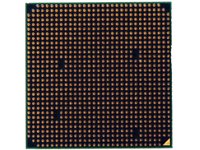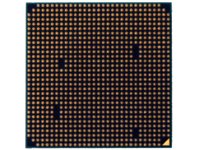Socket AM3: AMD's Phenom II Gets DDR3
Introduction
Running in second place is a strong motivator to do things differently—or even better—than your competition. For AMD, that has meant trying to develop a reputation for smoother, less disruptive platform transitions.
When Intel launched Core i7, it was a given that you’d need an X58 motherboard with the company’s LGA 1366 interface. Before that, LGA 775 served the Core micro-architecture well. But again, that was a complete departure from Socket 478, as the device required a completely new motherboard. Each step of the way, Intel has tweaked the packaging of its CPUs, altering thermals and mechanical load limits. Each new socket has addressed those alterations in kind.
A History Of Smoother Socket Launches?
Say what you will about its current performance deficit versus Intel’s fastest Core i7 processors, but AMD’s approach to adding functionality and shifting platform technologies has arguably been a bit less disruptive—at least on the surface. Missing from the below chart is Socket 940 and Socket AM2+. Socket 940 was only somewhat relevant to enthusiasts who purchased high-end Athlon 64 FX chips. And Socket AM2+ is perhaps the best example of AMD unveiling a new socket without stranding customers who invested in AM2. You could drop a newer AM2+ CPU in an older AM2 board and not run into trouble, aside from losing split power plane and HyperTransport 3.0 support.


What the table doesn't reflect are the situations where a new 140 W CPU might fit into a given socket, but still not work due to a motherboard design inadequacy (AMD and early 780G boards) or a fresh micro-architecture is launched on an existing platform, requiring new motherboards as a result of voltage changes (Intel and its Conroe).
| Disruptive Socket Launches | ||
|---|---|---|
| Year | AMD | Intel |
| 2001 | Row 1 - Cell 1 | Socket 478 |
| 2002 | Row 2 - Cell 1 | Row 2 - Cell 2 |
| 2003 | Socket 754 | Row 3 - Cell 2 |
| 2004 | Socket 939 | LGA 775 |
| 2005 | Row 5 - Cell 1 | Row 5 - Cell 2 |
| 2006 | Socket AM2 | (Intel launches Core 2 Duo, most motherboards need to be replaced) |
| 2007 | Row 7 - Cell 1 | Row 7 - Cell 2 |
| 2008 | Row 8 - Cell 1 | LGA 1366 |
| 2009 | (Socket AM3–new processors work in old motherboards, but not the other way around) | Row 9 - Cell 2 |
Now, with the unveiling of Socket AM3, AMD brings half of that same story over to its newest PGA-ZIF interface. You see, AM3 processors include the DDR2 and DDR3 memory controllers needed to drop into either AM2/AM2+ or AM3 motherboards. However, aging AM2/AM2+ processors don’t have the DDR3 memory controller to drop into an AM3 motherboard. We have to imagine more enthusiasts would be interested in adopting modern 45 nm CPUs and recycling their platforms than keeping a dated processor, hoping to only upgrade the motherboard, so that's an acceptable trade-off to us. Just to be sure no mistakes are made, AM3 processors come armed with 938 pins—two shy of the 940 needed in an AM2/AM2+ configuration.
Get Tom's Hardware's best news and in-depth reviews, straight to your inbox.
-
groo I sure don't see the point of spending cash on DDR3 unless you are also spending cash on i7. I woudn't mind a CPU that can handle DDR3 in the future, but there sure isn't a reason toupgrade to it at today's memory prices.Reply -
Aatish nice review... but....Reply
strangely AMD is performing better than core i7 920!
what did I miss? in previous benchmark done by you guys showed AMD performing quite less than what I see in this benchmark! can anyone clear my confusion? please!:) -
Commlock Very good test indeed that shows, IMHO, to go with an overclocked Core i7 if DDR3 is to be preferred. Otherwise, sticking with DDR2 RAM, an AM2+ MoBo and A Phenom II 940-like CPU seems the best optimized system. However, concerns can be put forward on the continuity of the system in couple of years' time, where simply upgrading without major component changes can be discussed.Reply -
I understand the fact that you guys compare cpu's in the same price region plus whats available to you and the socket upgrade and all that. But i would really like to see how the AMD 940 Black Edition compare to Intel Corei7 EE 965. And maybe include the corei7 940 to. An all out performance battle with just the benchmark figures that countsReply
-
waffle911 ReplyThe 940 runs at 3 GHz. The 920 and 720 both cruise at 2.8 GHz. But the 910, 810, and 710 all run at 2.6 GHz. There goes the idea that each increment of 10 corresponds to 100 MHz. The 805 chugs along at 2.5 GHz.
Looks to me like every increment of 10 in the designation yields a 200MHz clock increment, and 5 being 100MHz. But then either the 940 should actually be the 930. Then again, Volvo's recent product nomenclature doesn't add up, either. the V50 is the wagon variant of the S40, and the V70 was the wagon variant of the S60, but is now of the new S80. But they can't change it to V90 because then the Cross-Country variant of the V70 would have to be called he XC90 instead of XC70—but they already have an XC90 SUV. Digging themselves into a hole of consumer confusion, AMD and Volvo both.
But why is AMD shafting early adopters by shutting out AM2+ PhenomII from the AM3 platform without even offering an AM3 920/940? -
Well, can't agree with socket chart.Reply
Let's see (long run)
AMD&Intel: Socket 7 (intel up to some 266MHz?, AMD up to 550MHz)
Intel Slot 1 - with FCPGA adapters up to some 1200MHz?
AMD SlotA - with socketA adapters up to some 1600MHz?
PPGA s370 ~ 600MHz?
FCPGA (coppermine) 1100MHz
FCPGA2 (tualatin) 1500MHz?
Guess what...PPGA/FCPGA/FCPGA2 were the same socket (s370).
Now...SocketA ranged from 800MHz Durons to 2GHz AthlonXP 3200+
P4 start was with socket 423, but intel soon abandoned it for 478, however there were some adapters for some CPUs which allowed s478 CPUs to work on s423 mobos.
AMD with A64 introduced single channel DDR platform on s754. Later in 939 there was enhancement with dual channel and dual core. But then DDR2 appeared with quite low prices - so they moved to AM2.
Intel brought LGA775, but most chipsets for Prescott couldn't handle Core 2, later C2D FSB800MHz chipsets couldn't handle FSB1066 and 1333MHz C2D/C2Q cpus. And now we get LGA1366, 1156 and some more for the same familly. Well, I guess intel is more disruptive than AMD. I can put PhenomII 810 AM3 to my AM2 mobo on M1695+NF3, some NF3 ASRock users can do that too. AM2/2+/3 is on the best way to be worthy SocketA successor. -
raden_muaz I've been waiting for so long for this phenom ii to come.Reply
At last, phenom beats i7 in some kind of way.
Anyway, I never bought Intel for years because:
http://stopthewall.org/worldwideactivism/982.shtmlhttp://www.inminds.co.uk/boycott-intel.html
-
sohei there are 5 sokets technically but 2 physicallyReply
am2
am2/am2+
am2+
am2+/am3
am3
my question is : somebody try a am2/am2+ with a am3 cpu?
